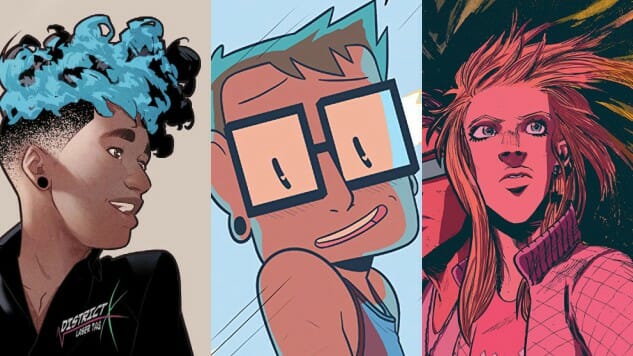Authentic Trans & Nonbinary Representation in Comics Requires More Than Just a Plot Twist
How The Backstagers’ Beckett Blazes a New Trail for Trans Comic Characters
Main Art by Jamal Campbell, Rian Sygh & Eryk Donovan
The first time I encountered a trans man in comics, it was in an issue of Alex di Campi and Carla Speed McNeil’s No Mercy centered around the experience of being shipped off to a conversion therapy camp by their parents. That’s not exactly light reading, but when you’re a reader from a marginalized group hungering for any fleeting glimpse of yourself in mainstream media, there’s a sense of obligation that you’ve got to lift up everything, even when it stings. I reflect on this issue with surprising frequency, and just as frequently find myself struck by how strange it is that, if I’d been able to wait for just three months more, my first experience with a trans masc character might have been with the one who remains my absolute favorite to this day.
The Backstagers is so profoundly different from No Mercy that beyond sharing a limited demographic, there are zero comparisons. That’s the odd conundrum of chasing after representation in a small medium, though: comics that have no business sharing a conversation often do, by virtue of their effort to include a character or two from the same community. Co-created by series artist Rian Sygh and writer James Tynion IV, The Backstagers is a joyful and sometimes spooky comic—soon to be a middle-grade book series written by Broadway performer Andy Mientus with illustrations from Sygh—about a ragtag band of theater kids and the mysterious, magical realm that helps them bring productions to life on stage. I love all of these characters equally, but Beckett a little more: the tech-savvy genius with a tight grip on all things electronic in the all-boys St. Genesius school theater, who we later discover is a transfer student from St. Genesius’ all-girls sister school.

Backstagers Interior Art by Rian Sygh & Walter Baiamonte
Beckett is never necessarily revealed as trans in The Backstagers the way most readers come to expect with trans characters. From Alysia Yeoh in Gail Simone’s Batgirl to No Mercy or more recent works like AfterShock’s Alters, there’s an element of surprise often associated with these moments, particularly in media from cis writers (though Alters colorist Tamra Bonvillain, a trans woman, is heavily involved in the creative process for that book). I seem so normal, you never would have guessed. Trans stories primarily guided by cis writers often center around trans identity in ways that are easiest for cis writers to grasp, giving us those moments of too normal to tell, or stories about bigotry and discrimination. There’s a subtle undercurrent at times that the real trans struggle is just surviving long enough for no one to be able to tell we’re trans anymore, with no exploration of the ambient hiccups of transition.
That’s not to say there’s no place for stories about struggling, but instead, that the perception of that struggle is wildly different between the person experiencing it and the person on the outside, wanting to help. Supergirl #19, co-written by series writer Steve Orlando and guest writer Vita Ayala, introduces a nonbinary character in Lee Serano. Newly out to themselves and struggling to work out how to begin sharing their identity with others, Lee faces bullying and an uncomfortable home life that will feel familiar to a number of queer readers. But by elevating the voice of Ayala, a nonbinary writer, there’s a level of authenticity here that strips away the element of playing voyeur to another community’s struggles. There are nuances in Supergirl #19 that are often missing from trans and nonbinary stories—perhaps most importantly that exploring your gender isn’t necessarily about flipping a switch that makes you instantly recognizable as “someone new,” but creating a family of people who will tell you, no matter what about you changes, that you are valid.

Supergirl #19 Cover Art by Jorge Jimenez & Alejando Sanchez
-

-

-

-

-

-

-

-

-

-

-

-

-

-

-

-

-

-

-

-

-

-

-

-

-

-

-

-

-

-

-

-

-

-

-

-

-

-

-

-










































